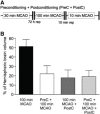Post-conditioning and reperfusion injury in the treatment of stroke
- PMID: 25552959
- PMCID: PMC4267451
- DOI: 10.2203/dose-response.14-026.Simon
Post-conditioning and reperfusion injury in the treatment of stroke
Abstract
Endogenous mechanisms of protection against ischemia can be demonstrated in brain and other organs. The induction of such protection is via a response to sub lethal stress which induces "preconditioning". The preconditioned organ is then "tolerant" to injury from subsequent severe stress of the same or different etiology. Protection is substantial (70% reduction) but delayed in onset and is transient. Gene expression is unique between brains preconditioned, injured (stroke) or made tolerant. Thus, preconditioning reprograms the response to lethal ischemic stress (stroke), reprogrammed from an injury induction response to a neuroprotective processes. Postconditioning refers to attenuation of injurious processes occurring during reperfusion of ischemic brain. Transient mechanical interruption of reperfusion induces post-conditioning which can attenuate reperfusion injury. Post-conditioning protects ischemic brain by decreasing reperfusion induced oxygen free radical formation. The free radicals produce injury via mitochondrial damage which can be repaired experimentally. Post-conditioning produces neuroprotection as potent as experimental preconditioning. The recognition of broad based gene silencing (suppression of thousands of genes) as the phenotype of the preconditioned, ischemic tolerant brain, may explain failure of all single target drugs for stroke. As risks of reperfusion injury accompany treatment for acute stroke, endogenous neuroprotective and repair mechanisms offer translational stroke therapy.
Keywords: Preconditioning; ischemia; post-conditioning; stroke.
Figures




Similar articles
-
Limb remote ischemic per-conditioning in combination with post-conditioning reduces brain damage and promotes neuroglobin expression in the rat brain after ischemic stroke.Restor Neurol Neurosci. 2015;33(3):369-79. doi: 10.3233/RNN-140413. Restor Neurol Neurosci. 2015. PMID: 25868435 Free PMC article.
-
Remote ischemic preconditioning: a novel protective method from ischemia reperfusion injury--a review.J Surg Res. 2008 Dec;150(2):304-30. doi: 10.1016/j.jss.2007.12.747. Epub 2008 Jan 22. J Surg Res. 2008. PMID: 19040966 Review.
-
Ischemic Post-Conditioning Induces Post-Stroke Neuroprotection via Hsp70-Mediated Proteasome Inhibition and Facilitates Neural Progenitor Cell Transplantation.Mol Neurobiol. 2017 Oct;54(8):6061-6073. doi: 10.1007/s12035-016-0137-3. Epub 2016 Oct 3. Mol Neurobiol. 2017. PMID: 27699598
-
Remote ischemic per-conditioning: a novel therapy for acute stroke?Stroke. 2011 Oct;42(10):2960-2. doi: 10.1161/STROKEAHA.111.622340. Epub 2011 Aug 11. Stroke. 2011. PMID: 21836089
-
NCX as a key player in the neuroprotection exerted by ischemic preconditioning and postconditioning.Adv Exp Med Biol. 2013;961:223-40. doi: 10.1007/978-1-4614-4756-6_19. Adv Exp Med Biol. 2013. PMID: 23224883 Review.
Cited by
-
Commentary: Can astrocytic mitochondria therapy be used as antioxidant conditioning to protect neurons?Cond Med. 2022 Dec;5(6):192-195. Cond Med. 2022. PMID: 38037662 Free PMC article.
-
Pharmacologic Protection of Mitochondrial DNA Integrity May Afford a New Strategy for Suppressing Lung Ischemia-Reperfusion Injury.Ann Am Thorac Soc. 2017 Sep;14(Supplement_3):S210-S215. doi: 10.1513/AnnalsATS.201706-438MG. Ann Am Thorac Soc. 2017. PMID: 28945469 Free PMC article. Review.
-
Remote ischemic conditioning for acute stroke patients treated with thrombectomy.Ann Clin Transl Neurol. 2018 Jun 6;5(7):850-856. doi: 10.1002/acn3.588. eCollection 2018 Jul. Ann Clin Transl Neurol. 2018. PMID: 30009202 Free PMC article.
-
rt-PA with remote ischemic postconditioning for acute ischemic stroke.Ann Clin Transl Neurol. 2019 Jan 16;6(2):364-372. doi: 10.1002/acn3.713. eCollection 2019 Feb. Ann Clin Transl Neurol. 2019. PMID: 30847368 Free PMC article.
-
DNA damage related crosstalk between the nucleus and mitochondria.Free Radic Biol Med. 2017 Jun;107:216-227. doi: 10.1016/j.freeradbiomed.2016.11.050. Epub 2016 Nov 30. Free Radic Biol Med. 2017. PMID: 27915046 Free PMC article. Review.
References
-
- Ballinger SW, Patterson C, Yan CN, Doan R, Burrow DL, Young CG, Yakes FM, van Houten B, Ballinger CA, Freeman BA, Runge MS. Hydrogen peroxide- and peroxynitrite-induced mitochondrial DNA damage and dysfunction in vascular endothelial and smooth muscle cells. Circulation Research. 2000;86:960–6. - PubMed
-
- Barone FC, White RF, Spera PA, Ellison J, Currie RW, Wang X, Feuerstein G. Ischemic preconditioning and brain tolerance: temporal histological and functional outcomes, protein synthesis requirement, and interleukin-1 receptor antagonist and early gene expression. Stroke; a Journal of Cerebral Circulation. 1998;29:1937–50. discussion 1950–1. - PubMed
-
- Brodrick JP, Palesch YY, Demchuk AM, Yeatts SD, Khatri P, Hill MD, Jauch EC, Jovin TG, Yan B, Silver FL, von Kummer R, Molina CA, Demaerschalk BM, Budzik R, Clark WM, Zaidat OO, Malisch TW, Goyal M, Schonewille WJ, Mazighi M, Engelter ST, Anderson C, Spilker J, Carrozzella J, Ryckborst KJ, Janis LS, Martin RH, Foster LD, Tomsick TA. Endovascular therapy after intravenous t-PA versus t-PA alone for stroke. The New England Journal of Medicine. 2013;368:893–903. - PMC - PubMed
-
- Chen D, Minami M, Henshall DC, Meller R, Kisby G, Simon RP. Upregulation of mitochondrial base-excision repair capability within rat brain after brief ischemia. Journal of Cerebral Blood Flow and Metabolism : Official Journal of the International Society of Cerebral Blood Flow and Metabolism. 2003;23:88–98. - PubMed
-
- Chimowitz MI. Endovascular treatment for acute ischemic stroke—still unproven. The New England Journal of Medicine. 2013;368:952–5. - PubMed
LinkOut - more resources
Full Text Sources
Other Literature Sources
Research Materials

